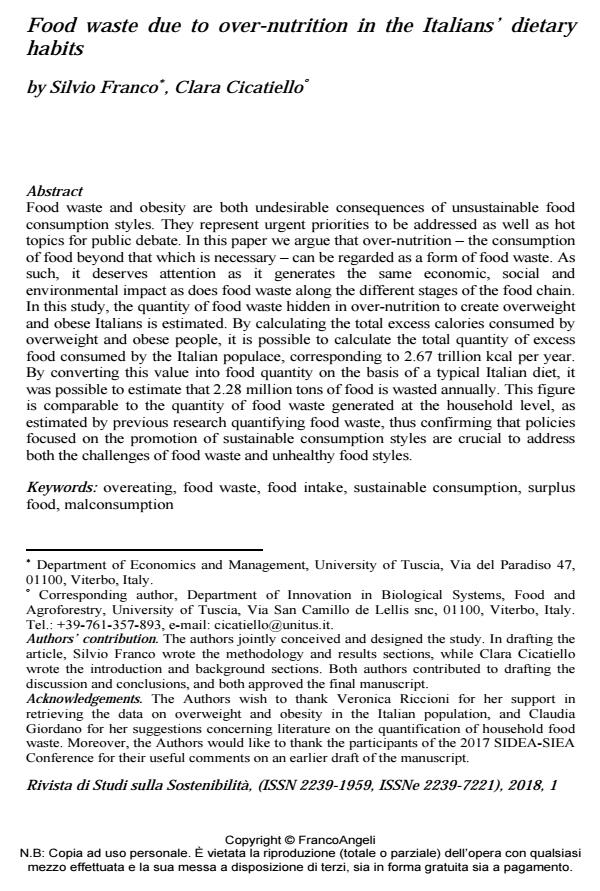Food waste due to over-nutrition in the Italians’ dietary habits
Titolo Rivista RIVISTA DI STUDI SULLA SOSTENIBILITA'
Autori/Curatori Silvio Franco, Clara Cicatiello
Anno di pubblicazione 2018 Fascicolo 2018/1
Lingua Inglese Numero pagine 0 P. 159-180 Dimensione file 291 KB
DOI 10.3280/RISS2018-001012
Il DOI è il codice a barre della proprietà intellettuale: per saperne di più
clicca qui
Qui sotto puoi vedere in anteprima la prima pagina di questo articolo.
Se questo articolo ti interessa, lo puoi acquistare (e scaricare in formato pdf) seguendo le facili indicazioni per acquistare il download credit. Acquista Download Credits per scaricare questo Articolo in formato PDF

FrancoAngeli è membro della Publishers International Linking Association, Inc (PILA)associazione indipendente e non profit per facilitare (attraverso i servizi tecnologici implementati da CrossRef.org) l’accesso degli studiosi ai contenuti digitali nelle pubblicazioni professionali e scientifiche
Food waste and obesity are both undesirable consequences of unsustainable food consumption styles. They represent urgent priorities to be addressed as well as hot topics for public debate. In this paper we argue that over-nutrition - the consumption of food beyond that which is necessary - can be regarded as a form of food waste. As such, it deserves attention as it generates the same economic, social and environmental impact as does food waste along the different stages of the food chain. In this study, the quantity of food waste hidden in over-nutrition to create overweight and obese Italians is estimated. By calculating the total excess calories consumed by overweight and obese people, it is possible to calculate the total quantity of excess food consumed by the Italian populace, corresponding to 2.67 trillion kcal per year. By converting this value into food quantity on the basis of a typical Italian diet, it was possible to estimate that 2.28 million tons of food is wasted annually. This figure is comparable to the quantity of food waste generated at the household level, as estimated by previous research quantifying food waste, thus confirming that policies focused on the promotion of sustainable consumption styles are crucial to address both the challenges of food waste and unhealthy food styles.
Parole chiave:Overeating, food waste, food intake, sustainable consumption, surplus food, malconsumption
- Such a Shame! A Study on Self-Perception of Household Food Waste Luca Falasconi, Clara Cicatiello, Silvio Franco, Andrea Segrè, Marco Setti, Matteo Vittuari, in Sustainability /2019 pp.270
DOI: 10.3390/su11010270 - Quantifying metabolic food waste and associated global warming potential attributable to overweight and obese adults in a temperate high-income region Courage Y. Krah, Daniel T. Burke, Majid Bahramian, Paul Hynds, Anushree Priyadarshini, in Food Research International 116309/2025 pp.116309
DOI: 10.1016/j.foodres.2025.116309 - Social Emotions and Good Provider Norms in Tackling Household Food Waste: An Extension of the Theory of Planned Behavior Francesco La Barbera, Mario Amato, Roberta Riverso, Fabio Verneau, in Sustainability /2022 pp.9681
DOI: 10.3390/su14159681
Silvio Franco, Clara Cicatiello, Food waste due to over-nutrition in the Italians’ dietary habits in "RIVISTA DI STUDI SULLA SOSTENIBILITA'" 1/2018, pp 159-180, DOI: 10.3280/RISS2018-001012